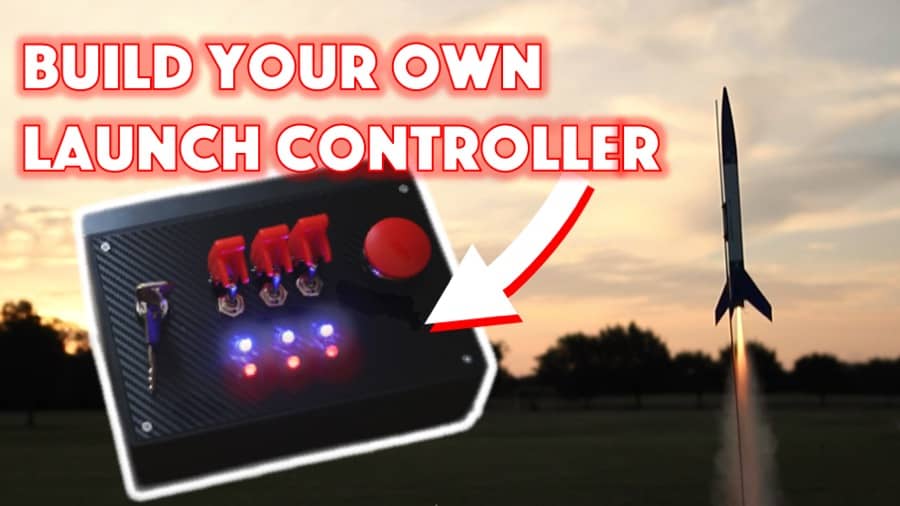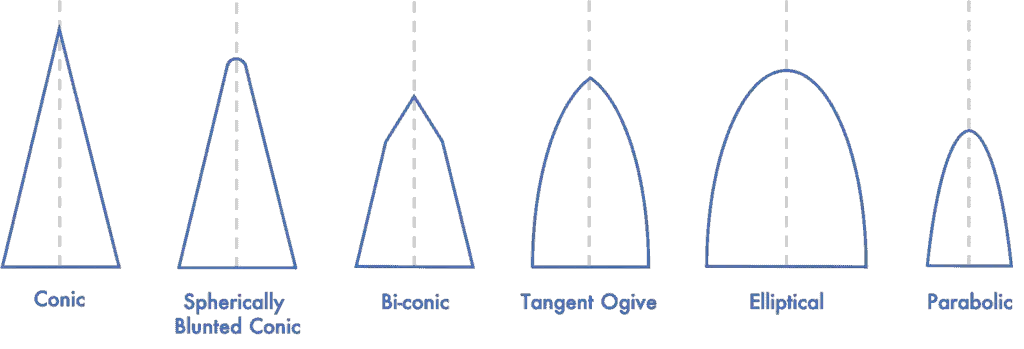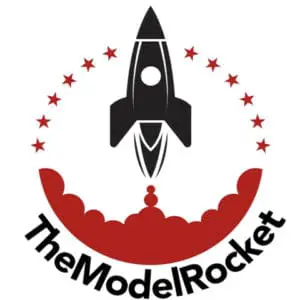
When it comes to model rocket nose cones, nose cone design is almost a discipline in rocketry all its own. The shape and construction of a nose cone impact the aerodynamics of the overall rocket, and subsequently, whether it’ll fly or not.
So what do you need to know about model rocket nose cones?
Model rocket nose cones vary in shape, which each have unique properties of drag that affect the overall aerodynamics and efficiency of the model rocket itself. Compared to other designs, elliptical and parabolic nose cones tend to be the most efficient due to their reduced drag.
This guide will summarize the following:
- How rocket nose cones factor into aerodynamics
- How rocket nose cones affect the flight of a rocket
- Types of model rocket nose cones
- Materials commonly used for model rocket nose cone construction
- How to measure model rocket nose cones
Whether you’re constructing a prefabricated model rocket or designing a handcrafted one of your very own, understanding the aerodynamic design of nose comes is crucial to understanding the overall science of rocketry and how a rocket gets off the ground.
Are you still using the standard Estes controllers for your launches?
We just built our own beautiful launch controllers that make launches SO much more fun, and we documented EVERY single step and item purchased and put it into a step-by-step course that teaches you how to do the exact same thing.
Click here to learn more about how you can build your own launch controllers!

Model Rocket Noses and Aerodynamics
Aerodynamics is (according to NASA) the science of how air moves around objects and is also the science of how physical objects are able to fly. The science of aerodynamics affects natural occurrences such as bird flight, but it is of supreme interest to scientists when it comes to aerospace engineering.
Aerodynamics consists of the four physical forces that are exerted on an object when it is flying through the air: lift, thrust, drag, and weight (gravity).
The aspect of aerodynamics most heavily influenced by the nose cone of a model rocket is drag, also known as air resistance. The more drag an object has, the more thrust it requires to lift it.
How do Model Rocket Noses Affect the Flight of a Rocket?
As discussed in the previous section, model rocket nose cones affect the drag on a rocket, but how does that affect its flight? This comes back to the aerodynamic force of drag, which is in opposition to the aerodynamic force of thrust provided by the rocket’s motor.
The smaller the diameter of a rocket’s nose cone, the faster the rocket can be launched in proportion to the amount of thrust provided.
This means that rockets with pointed nose cones are capable of moving very quickly. This is the same design shared by airplanes designed to go supersonic, such as the Lockheed Martin SR-71 Blackbird stealth plane.
In contrast, commercialized aircraft are usually designed with a parabola or elliptical nose cone design due to decreased drag and increased efficiency.
For the highest possible altitude, a rounded, parabolic shape is best when designing a model rocket nose cone. However, there are many different kinds of model rocket nose cone shapes that have been used throughout the history of the hobby.
Types of Model Rocket Nose Cones
There are many different kinds of model rocket nose cones with various levels of aerodynamic effectiveness. Here are some of the types of model rocket cones:

- Conic nose shape: Conic nose shapes are rocket noses that come to a point. These rocket noses call back to the first days of modern rocketry, and are often found in model rocket replicas of old rockets such as the Saturn V. This rocket nose design is easy to construct, but not very aerodynamic in comparison to more rounded designs.
- Spherically blunted conic nose shape: This rocket nose shape is a cone shape in basic design but features a spherical endpoint.
- Bi-conic nose shape: Bi-conic nose shapes feature a two-cone design with a secondary cone stacked at the frustum of the first cone shape. This results in a staggered but planed tapering effect.
- Tangent ogive: Other than classic conical nose cones, tangent ogive nose cones are one of the most easily recognized designs in model rocketry. This is also a popular design shape for the construction of bullets.
- Elliptical: Elliptical nose cone designs feature a blunt nose and a tangent base, making them popular in low-powered model rocketry because they are very aerodynamic at relatively low speeds (subsonic flight).
- Parabolic: Parabolic nose cone designs are a rounded nose cone design like elliptical nose cones, but aren’t necessarily at a flat angle at the point the nose cone meets the rocket body tube. Parabolic and elliptical shaped nose cones have been adopted in many commercial aircraft due to the reduced drag and corresponding reduced fuel consumption.
There are a few advantages and disadvantages regarding conical rocket nose shapes vs. rounded nose shapes. Here is an overview of the basic differences between the two:
- Conical (and to a lesser degree ogive) cone designs are more effective at trans-sonic and supersonic speeds.
- Elliptical and parabolic cone designs are more effective at subsonic speeds (which is the speed almost all model rockets operate under).
- In general, accurate elliptical and parabolic nose cone designs are more difficult to accurately construct than conical designs.
Materials Used in Model Rocket Nose Cones
Model Rocket Nose Cones can be constructed from a wide variety of materials, and these materials have a range of effects on the overall weight and aerodynamics of the rocket.
Common materials used to build model rocket nose cones include the following:
- Plastic: Prefabricated plastic model rockets (like those listed in our guide for best beginner model rockets) are most commonly constructed from high impact polystyrene (HIPS) or polyethylene. These plastics have the benefit of being both durable as well as lightweight.
- Balsa wood: Balsa wood is a suitable wood for many kinds of craft and artisan applications since it is one of the world’s lightest woods. Many prefabricated components of model rockets are created out of balsa wood, such as model rocket fins.
- Hardwood: Hardwood is sometimes used in the construction of handmade rockets, but is not as commonly used due to its high weight to volume ratio. However, it is one of the easier model rocket materials to source and is relatively inexpensive.
- Fiberglass: Fiberglass is a common component in prefabricated model rockets, and is prized for being chemically inert, malleable, and stronger than many metals under load while remaining lightweight.
- Styrofoam: Rigid Styrofoam sheets are a good choice for model rocket construction because they are light, stiff in construction, and relatively easy to shape. Styrofoam also has the benefit of being flame retardant.
- Cardstock or paper: While paper and cardstock nose cones aren’t as sturdy as some of the other materials in this list, these materials are easily found around the house and
are inexpensive, which makes them a good choice for casual rocketry and experimental
design work.
Some of these materials, such as hardwood and balsa wood, are easier for those rocketeers who are having to construct their model rocket nose cones from a garage or workshop.
However, with the advent of 3D printing in model rocket design, lightweight plastics are quickly becoming a popular choice for constructing more smooth and accurate nose cones.
Several factors determine the materials used for model rocket construction.
Wood, paper, and certain plastics are more often found in handcrafted model rockets, while plastic and fiberglass are popular construction materials in model rocket replicas of full-scale rockets.
Model rocket nose cones can be either designed to be solid or hollow. Hollow nose cones weigh less and as a result, create less oppositional force to thrust, so this is a design factor often included to decrease overall rocket weight.
What you decide to build your model rocket nose out of will be largely determined by what kind of resources you have to build with. If you have a 3D-printing station or a wood shop, you’re going to have much different options than someone who doesn’t have easy access to
those tools.
Building Your Own Model Rocket Nose Cone
If you’re building your own model rocket nose cone from scratch, you’ll need to consider the time and energy investment required to design your own versus having a model rocket delivered to your door.
While there is something to be said for having created your own model rocket from the ground up, designing a rocket piece by piece is intricate science.
Luckily, there are some ways to test the design of a nose cone to determine how effective it will be, both prior to construction and during/after launch.
It can pay to do a little bit of this theoretical legwork up front before you start construction so that you can resolve any design flaws before the rocket is built out.
Before you ever start building your rocket, one way to determine the most aerodynamic nose cone design is to design your rocket in a simulator.
There are several programs available that allow you to see exactly how your rocket would perform in a flight simulation. Here are some of the programs you can use to test the aerodynamic qualities of your nose cone design:
- SpaceCAD: SpaceCAD allows you to do a fully integrated flight analysis and simulation of your launch, including factors like recovery parachutes. For rocketeers who are serious about learning how to design their own model rocket nose cones from the ground up, SpaceCAD is essential.
- OpenRocket: OpenRocket is a freeware model rocket simulation software, so for rocketeers who are just getting started in the hobby and are tight on funds, this is a good choice for enhancing your rocket design process for more accurate and impressive results at launch.
- RockSim: RockSim is the model rocket flight simulator software of Apogee Rockets, arguably one of the largest model rocket manufacturers on the market. This is a good choice for anyone who is wanting to mix and match various prefabricated Apogee model rocket components
as well.
Model Rocket Nose Cone Performance Evaluation
The best way to find a nose cone design that will be right for your launch is to experiment with several different nose cone designs before committing to one for construction.
After you’ve constructed your nose cone, however, you can actually test the aerodynamics of your nose cone design by using sensors such as accelerometers and altimeters.
- Accelerometers: Accelerometers are sensors that can provide data from the flight such as speed, acceleration, g-forces, and more.
- Altimeters: Altimeters are sensors that measure the altitude of the flight.
Here’s our starter guide to model rocket accelerometers and altimers.
If you’ve already designed and built a model rocket, installing an accelerometer and an altimeter as the model rocket’s payload can allow you to capture flight data during the launch that will give you some serious insights into how to increase your flight performance for the next run, and can also tell you objectively which nose cone shape leads to a higher or faster launch.
Not only that, accelerometers and altimeters can also tell you about the other design variables impacting your rocket’s flight pattern, such as the fins or body contours.
If you are serious about improving your model rocket designs, these sensors can give you the information you need to know to push your designs to the next level.
By recording your flight data whenever you launch one of your constructed rockets, you can measure statistics such as maximum speed and maximum altitude as well as create an overall acceleration profile.
Once you have this data in hand, you’ll have a much stronger visual concept of how well your rocket is actually performing in flight versus a simulation.
How to Choose Accelerometers and Altimeters to Evaluate Nose Cone Performance
When choosing accelerometers and altimeters to enhance your rocket flights, keep the following things in mind before installation:
- Payload size and location: When adding a payload to a model rocket (here are our 16 payload ideas for model rockets), you need to account for the change in weight and overall balance. Adding things to the rocket’s design can seriously alter the way that it reacts on an aerodynamic level. Rockets that are going to be flown competitively will also want to maintain the lightest overall weight possible to remain competitive.
- Power source: Accelerometers and altimeters come battery-powered, but some of them can be recharged via a USB port.
- Data recovery: Accelerometers and altimeters recover launch data in different ways depending on the model of sensor.
Many of these sensors are linked into a computer “mission control” prior to launch and sync the data wirelessly to the computer during launch using a Bluetooth connection. Some of these sensors transfer data directly to your smartphone rather than a computer.
These sensors will not only allow you to measure which nose cone shape is more aerodynamically effective, they will also allow you to measure how effective various construction materials and other design aspects are as well, and what impact they have on flight performance of the model rocket.
Competitive Model Rocket Design
The reason nose cone design is so important is because it affects two different aspects of flight that are measured during model rocket flight competitions: flight duration (how long the rocket remains airborne) and altitude (how high it goes before it begins its descent).
When constructed with a nose cone design that is less aerodynamic than its competitors at the basic mathematical level, a model rocket is destined to not fly as high as its sleeker rivals. This is why understanding the concepts behind rocket design are just as important as the construction of the rockets.
Those rocketeers who design model rockets as a leisurely hobby can afford to be radical in their experimentations with regards to how they build their rockets. However, those who want a serious competitive edge need to be a bit more meticulous in their choice of both nose cone design and material construction.
Model Rocket Nose Cones Are a Vital Aspect of Model Rocket Design
Designing and constructing your own model rocket from the ground up is one of the most satisfying things you can do in the model rocket hobby. For a successful launch, it’s worth the effort to make sure that your design is perfectly balanced and constructed.
Because of their influence on air resistance and drag, designing an aerodynamic nose cone is one of the most important factors in ensuring that your overall model rocket design is going to have a successful flight.
